- What is Customer Retention?
- How to Track CR as a Key Business Metric?
- Why is Customer Retention Important? And Is It?
- How to Improve Your CR?
- 1. Target the Right Audience
- 2. Manage the Customer Journey
- 3. Be Where Your Customers Are
- 4. Construct Your Content Strategy Purposefully
- 5. Add a Human Touch
- 6. Personalize Offers
- 7. Send Onboarding Emails
- 8. Craft Follow-up Content Strategically
- 9. Prepare Interactions Proactively
- 10. Define Trigger Events and React to Them
- 11. Leverage Social Media
- 12. Reward High-Value Clients
- 13. Provide Customer Education Programs
- 14. Ask Customers For Feedback
- 15. Check and Fine-Tune Your Efforts Regularly
- Bringing it all Together
Customer Retention: Top 15 Effective Strategies to Make Clients Fall in Love with Your Product Over and Over Again
August 12, 2021 20 min. read

Contents:
Try AI-Driven Insights
Monitoring for Free
Discover new business ideas and growth opportunities using
our AI-powered insights monitoring tool
“A bird in the hand is worth two in the bush.” — you know what that’s about, don’t you? Customers!
Acquiring new customers is a significant challenge for any business. Even successful and established or fast-growing companies plan well in advance to increase revenue generated from marketing and manage risks associated with client turnover and a declining customer base. Such forward-thinking begins with placing a high value on retaining existing clients using customer retention strategies.
What is Customer Retention?
Customer Retention (CR) is a key strategic goal focusing on maintaining, rewarding, and learning from repeat, ongoing customers. Even dissatisfied clients have a place in a well-rounded CR strategy.
A strong CR track record aims to keep your customers happy and promote loyalty, supporting existing clients as part of an active sales and marketing “tool” to attract new clients using positive reviews and recommendations.
CR strategies begin with the very first customer interaction. If carefully maintained and cultivated, the value of the relationship will grow in ways that go far beyond just the simple sales profit from an individual sale. To keep a meaningful and practical record of how your company manages CR rates, you must focus on specific metrics.
How to Track CR as a Key Business Metric?
CR metrics should be a meaningful and comprehensive measurement of the effectiveness of your CR strategy. It’s crucial to track, monitor, and analyze your CR performance record to understand how effectively your overall approach works and highlight areas of weakness.
A good start is to track your customer retention ratio (CRR). To calculate your CRR, you need to subtract the number of new customers from total customers over a defined period. Next, divide that difference by the number of customers at the start of that period. Simple! The equation looks like this:
Customers you have at the end of the period – Customers acquired during the period you’re measuring / Customers at the start of the period
The higher the score, the better your CR strategy performs. If the score is low, then clients don’t stay long. But keep your heads high. Today we will tell you what you can do to fix it.
Why is Customer Retention Important? And Is It?
A wide range of valuation factors associated with CR is often ignored or underappreciated, making it a commonly misunderstood strategic asset.
The value of CR is explicitly tied to marketing ROI. When customers are satisfied and engaged, marketers can encourage that loyalty to empower them as brand ambassadors. Developing an aligned client base is a long-term strategy that goes beyond just making a sale. Most obviously, clients who share positive feedback can add value in many ways, beginning with customer acquisition goals. From small business owner-operators to board members of multinational conglomerates, “word of mouth” is always taken seriously.
When CR is high, marketing teams can track brand sentiment and customer fulfillment with a better degree of accuracy and attention to detail. Such insights, driven by real-life customer experiences, add credibility to all decision-making and strategy development. When marketing teams collect and organize client information, they can understand positive attributes and uncover areas requiring improvement.
Don’t limit your analysis to your marketing business unit only. CR efforts can also drive organization-wide improvements such as research and development priorities, production process, or individual employee performance. A well-informed CR strategy can become a real competitive advantage.
How to Improve Your CR?
Now let’s dive deep into some key marketing strategies that will boost a range of objectives. From daily tasks to long-term project planning, a comprehensive checklist of CR techniques will keep existing customers and attract new ones.
1. Target the Right Audience
How can a customer stay with you if your product didn’t quite fit them from the start? They could buy for various reasons — emotional buying is just one of the examples. Right from the get-go, know who your Ideal Customer is and focus on them. Thus, you will decrease the risk of spending time and money trying to keep customers who were not your perfect fit from the start.
Remember to keep a record about all customers in one place, filtered, segmented, and up to date so that you can clearly understand who is who and how to interact with them. Such tools as Signum.AI will help you here. In the future, the wealth of information you can gather from even the least-engaged existing clients adds value far beyond the limited and less valid information available from prospective clients.
2. Manage the Customer Journey
Even after your sales and marketing teams have guided your customers through their journey from prospect to a happy client, losing them to a competitor or because of some other CR misstep isn’t the only risk. You need to learn from them again and again so that their customer journey is repeated and results in new purchases.
The evolving customer journey of loyal and repeat clients specifically offers marketing solutions based on accurate information. The goal should be for the client experience to improve over time. Significantly, any lessons learned and strengths and weaknesses uncovered can enhance your marketing strategy and other efforts across the company. Take full advantage of the knowledge of your existing customers to personalize their customer journey.
Keep in mind that the way you market towards, educate and inform your oldest and most important clients should be entirely different from how you approach your newest customers planning and carrying out CR strategies.
3. Be Where Your Customers Are
CR strategies are particularly powerful because they can be developed with specific knowledge of where best to attend to your customers’ wants and needs — industry-specific media, social media, forums, etc.
And most importantly, being present where your customers are will remind them of your business and improve your chances of interacting with clients by delivering better content based on each particular “location” or channel.
Let’s look at it from a different perspective. Imagine that your customer has a question. Do they want to wait a day or two for a company representative to contact them, or do they want you to resolve their issue straight away?
Well, you get where we’re going with this — they should know where to go with confidence that they will get an immediate response. Whether it’s social media, a company forum, or live chat, make sure you respond in a timely manner.
Signum.AI, for example, effectively interacts with their customers and helps them resolve issues in a matter of minutes just using a chatbot. A very common but such an efficient practice!

4. Construct Your Content Strategy Purposefully
When you truly understand your customers — meaning, you know who they are, what they need from you, what their challenges are, and where they spend their time, you can deliver valuable content so that they will like to remain with you.
CR must emphasize tailored, well-informed content creation for use across various communication tools, such as blog posts, videos, webinars, and social media networks. Well-known marketing techniques such as deep segmentation, pain points, and interests help you provide what they want and need. Just because your CR audience is existing clients, it doesn’t mean they all share the same concerns.
Quality content keeps clients close, offers help proactively, and ultimately shows your customers how hard you’ve worked to understand how much you value them. An excellent example of implementing such a strategy comes from TED, an American media organization that posts talks online. Based on your view history, interests, and likes, they recommend a 100 percent hit rate content.
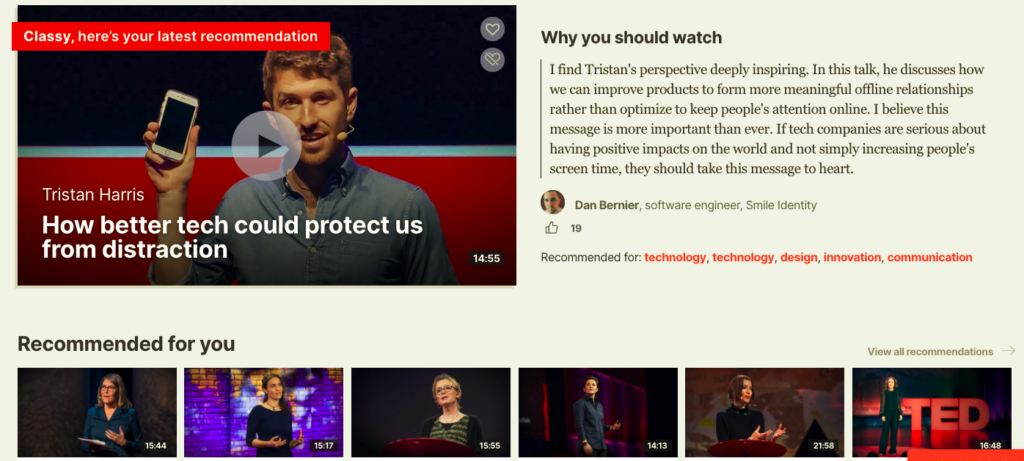
5. Add a Human Touch
In addition to broader, more obvious CR considerations such as content creation, timeliness, communication channels, and respect for the customer journey stages, why not extend such personalization efforts to include even the smallest of details. Often, it’s the little things like sending personalized emails to your customers’ birthdays, special occasions that count and help you stand out from the competition.
6. Personalize Offers
In addition to using a customer’s name in an email letter or chatbot, ensure that you put your customer’s most compelling interests forward — recommend products, services, or content that they might find helpful.
A famous example of such a strategy is Amazon which greets you by name and suggests products based on your purchase and search history.
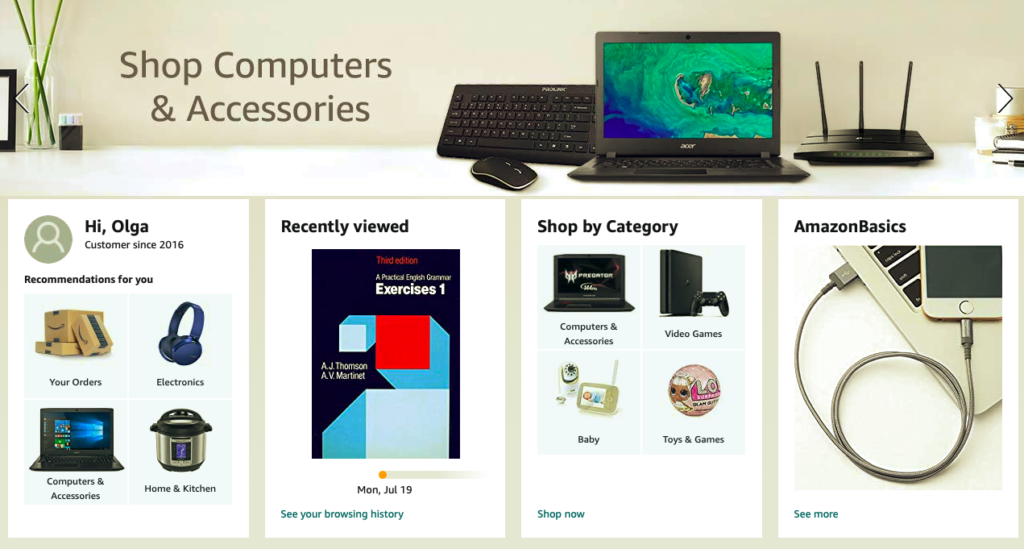
And you can do the same! Keep track of your customers’ browsing and purchase history, and use this information to tailor personalized offers. It will be even more effective if you align it with your email marketing strategy. An AI-based marketing software will help you to do that and facilitate engagement, ensuring that you are sending the right offer with almost no effort.
7. Send Onboarding Emails
As with any decent marketing strategy, email marketing is a crucial tool for CR. Although similar to CR strategies made without email in mind, the efficiencies and benefits of automation tools can be easier to implement.
Automated onboarding emails can drastically impact your CR. For example, Asana, an application designed to manage teamwork, does a great job by sending detailed onboarding emails to its new users that motivate them to use the platform to its full potential.



8. Craft Follow-up Content Strategically
Perhaps the most apparent path towards CR follow-up strategies, using even entry-level CRM software to program automated tools, is to add an informational advantage to many marketing strategies. In this case, the goal is more manageable, more tailored, and effective follow-up CR content. The more information you have, the easier it will be to tailor your follow-up strategies.
For software products, sending milestone messages is a great way to make customers continue to use your product because they give users a sense of progress that drives them to keep using it. So far, Grammarly has one of the best milestone engagement emails.

9. Prepare Interactions Proactively
At the risk of stating the obvious, try to collect and analyze as much feedback and information across as many client interactions regularly to plan and prepare solutions so that you anticipate their problems versus waiting for them to contact you in rage.
If you know you might be facing technical issues or changes in user policy, alert your customers so that they can plan their work accordingly.

10. Define Trigger Events and React to Them
Timing is everything when it comes to CR. Insights into your customers’ experience can be learned in real-time, allowing you to act upon real insights quickly and directly. One good example is tracking triggers — monitoring and analyzing information about your existing customers to have a reason to reach out.
Collect your customers’ digital footprints — all actions related to your or your competitors’ business that you might be able to act on. Including certain “trigger events” with a well-scheduled “communication calendar” ensures frequent, regular, and valuable CR engagements via email or any other channel you prefer to interact with your customers.
A noticeable wake-up call is a client being off your radar for a long time. Netflix come-back emails are perfect examples of how to deal with it.

With marketing automation tools, you will be able to access this data in real-time and use it to your advantage — tracking triggers and reacting with the right type of content.
11. Leverage Social Media
There’s no better place to cultivate relationships with your customers than on social media. From such industry giants as Twitter and LinkedIn to more niche platforms, social media is perfectly suited for online marketing — CR strategies included.
Post regularly on the social media channels your customers use and engage with your audience, prompting them to continue using your product or service.
Remember that the tie that binds CR to social media is “social proof.” Social proof is a bit like herd mentality — following the crowd. Social media allows you to leverage the “social proof” principle to boost CR success. Create groups and encourage targeted audiences to receive and share your CR-related messages. They can take all sorts of positive actions to make others want to get in on it.
And don’t forget to make your content more human and entertaining, and less formal. It’s social media anyway! Have a look at how amazingly a cosmetics brand Milk Makeup interacts with customers both on Twitter and Instagram by regularly featuring user-generated content, customer stories, insights, and tips.

12. Reward High-Value Clients
A customer loyalty program is a no-brainer for CR. For example, a points system rewards existing clients for repeat business, customer referrals, reviews, and feedback. Bodycare retailer Blume, for instance, uses points that customers can earn by following the brand on Instagram, placing orders, or leaving reviews. In such a way, they reward engagement levels as well as sales profits.
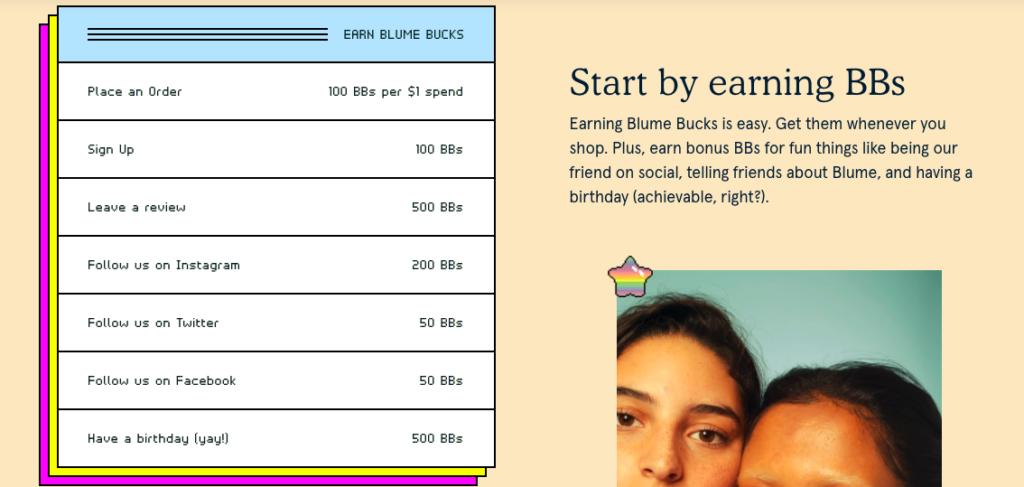
Even a simple policy of guaranteeing “best price” to a defined top-tier of existing clients is a strong incentive for loyalty. Making rewards easy for clients to understand and apply for can be the key to a good loyalty program.
13. Provide Customer Education Programs
Rather than contacting customer support for assistance, some clients prefer to resolve their problems on their own. That’s why a customer education program demonstrates a long-term investment in your customer base.
Engage your customers by educating and inspiring them in ways related to your product. Under this initiative, your business can create a variety of customer self-service tools like a knowledge base, a community forum, or webinars.
Webinars are a great CR tool and additional distribution channel in their own right. Host them regularly and use CR strategies to thoughtfully automate, prepare, schedule, and tailor the content. Take further advantage of webinars by using video-sharing sites. Add the recorded webinar to YouTube and on your website, for example.
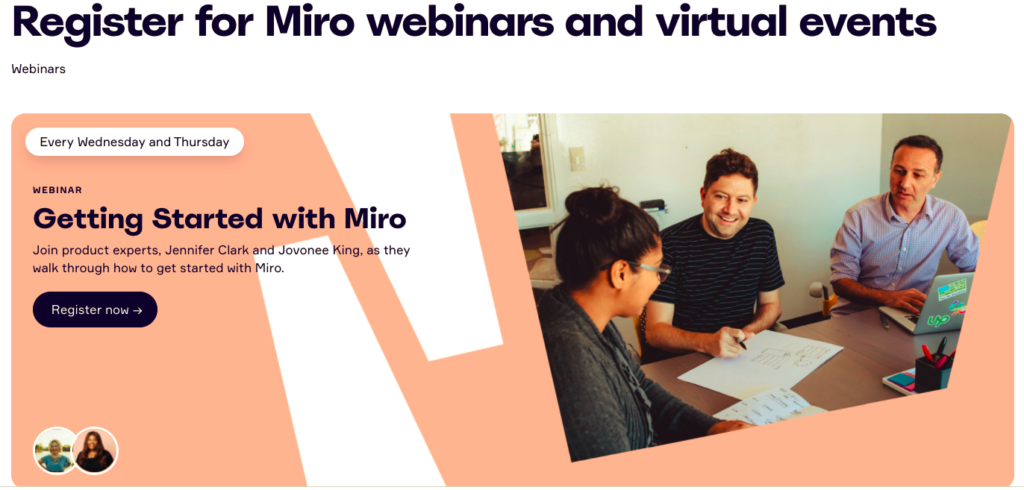
Miro, an online platform for team collaboration, is an excellent example of a company that educates and keeps its customers informed by introducing self-help solutions and webinars on their website that become a massive driver in CR.
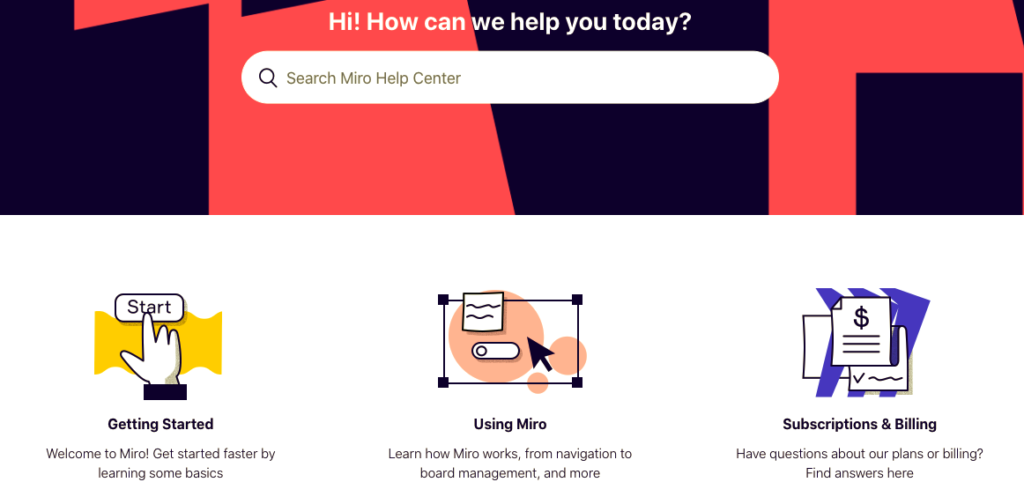
In such a way, customers can locate solutions to service problems before reaching out to your support team.
14. Ask Customers For Feedback
Asking customers for feedback engages them in the process, makes them feel important and offers individual support in resolving their issues.
On top of that, customer feedback gives you insights into how you may boost your overall CR efforts. For example, suppose you hear the same complaints about the hurdles of the onboarding process or that the product is not quite a fit for them. In that case, you know what to work on — smoothing your welcoming experience and tuning your marketing campaigns so that they target the right customers.
But remember to make your surveys user-friendly, easy and quick to fill out so as not to get on your customers’ nerves. And don’t forget to offer them a bonus that is worth the time it took them to give you feedback!
Usersnap, a customer feedback software, indeed knows how to collect feedback. As simple as it is — they ask you to rate their blog posts, getting to know your preferences in a matter of clicks!

15. Check and Fine-Tune Your Efforts Regularly
Highlight trends, revisions, and group analytics in themes when working with information from online reviews and surveys to better understand the customer experience as it happens. When changes are required, act fast.
If your emails’ open rates are low, or unsubscribes are rising, don’t keep resending the same type of content. Instead, test and re-optimize it. Experiment and test what kind of content works best for your customers — gets more likes, reposts, and interactions. The same applies to any sort of CR strategy.
Bringing it all Together
We cannot emphasize the importance of CR enough. Marketing, sales, customer service, and other management teams can all benefit from CR.
Especially now that automated strategies are so user-friendly and affordable, CR is one of the most valuable ways to maintain and grow your business. With just a little attention to certain strategies, you can help guarantee that customers return time and again.
Keep in mind that there is no universal CR strategy. Nor is there one marketing, sales, accounting, or other metrics to target. But with just a few universal guidelines and tools that fit your overall business goals, you can make sure that your clients are appropriately, actively, and sustainably involved in your organization.
More useful content on our social media:
